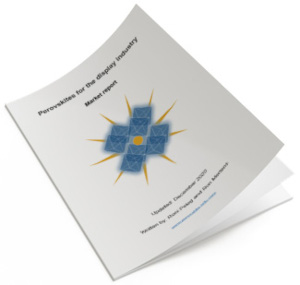Perovskite-Info weekly newsletter
Published: Tue, 04/06/21
The Perovskite-Info newsletter
April 6, 2021
Having trouble reading this email? View it online here.
Researchers design automatic light-adjusting electrochromic devices powered by perovskite solar cells
Scientists from the Southern University of Science and Technology in China have developed an automatic light-adjusting electrochromic device (ECD), powered by a perovskite solar cell (PSC), which they say can be used for all-day intelligent-curtains, and advanced electronic displays.

Electrochromic devices are able to reversibly change colors in response to an electric field and generally consist of multi-layer structures with transparent conductors, electrochromic films, ion conductors, and ion storage films. Although these devices are capable of modulating their light absorption under a small driving voltage, the requirement for external electrical supplies causes response-lag.
Researchers show that manipulation of antisolvent application rate can help create efficient and reproducible PSCs
Researchers from the Emerging Electronic Technologies Group of Prof. Yana Vaynzof at Germany's Technische Universität Dresden have found that fundamental processes that occur during perovskite film formation strongly influence the reproducibility of the photovoltaic devices.
When depositing the perovskite layer from solution, an antisolvent is dripped onto the perovskite solution to trigger its crystallization. "We found that the duration for which the perovskite was exposed to the antisolvent had a dramatic impact on the final device performance, a variable which had, until now, gone unnoticed in the field." says Dr. Alexander Taylor, a postdoctoral research associate in the Vaynzof group and the first author on the study. "This is related to the fact that certain antisolvents may at least partly dissolve the precursors of the perovskite layer, thus altering its final composition. Additionally, the miscibility of antisolvents with the perovskite solution solvents influences their efficacy in triggering crystallization."
Research team uses spray pyrolysis deposition to fabricate perovskite solar cells based on a titanium oxide electron transport layer
Researchers from Kanazawa University and Tokai University in Japan, in collaboration with other institutes, have developed a perovskite solar cell based on a titanium oxide (TiO2) compact electron transport layer (ETL), which they claim is the most efficient PV device of its kind to be produced at the research level to date.
They researchers used a spray pyrolysis deposition (SPD) technique, which is generally used for temperature decomposition of organic material in the absence of oxygen. This process is known to provide excellent rate capability and high cycling stability. It is used in the chemical industry to produce ethylene, carbon and chemicals from petroleum, coal and even wood, in addition to producing coke from coal.
A new method overcomes the drawback of perovskite grain boundaries by using 2D materials for conducting hole currents
A team of scientists, led by Professor Feng Yan from Department of Applied Physics, The Hong Kong Polytechnic University, Hung Hom, Kowloon, Hong Kong, and co-workers, recentky developed a novel method to overcome the drawback of grain boundaries (GBs) in perovskites without using defect passivation.
Several 2D materials, including black phosphorus (BP), MoS2 and graphene oxide (GO), were specifically modified on the edge of perovskite GBs by a solution process. The 2D materials have high carrier mobilities, ultrathin thicknesses and smooth surfaces without dangling bonds. The PCEs of the devices are substantially enhanced by the 2D flakes, in which BP flakes can induce the highest relative enhancement of about 15%.
China’s UtmoLight reports solar module efficiency of 20.5%, plans to build large-area production lines
China-based Wuxi Utmost Light Technology (UtmoLight) has announced that it has reached a new world record of 20.5% power conversion efficiency for its perovskite mini-module with a designated area of 63.98 cm2. The result was reportedly certified by the internationally recognized test center – Japan Electrical Safety & Environment Technology Laboratories (JET).
UtmoLight plans to build production lines for manufacturing large-area perovskite solar modules to accelerate the commercialization of its perovskite photovoltaic technology.
The Perovskite for Displays Market Report updated to April 2021
Perovskite-Info is proud to announce an update to our Perovskite for the Display Industry Market Report. This market report, brought to you by the world's leading perovskite and OLED industry experts, is a comprehensive guide to next-generation perovskite-based solutions for the display industry that enable efficient, low cost and high-quality display devices. The report is now updated to April 2021.
Reading this report, you'll learn all about:
- Perovskite materials and their properties
- Perovskite applications in the display industry
- Perovskite QDs for color conversion
- Prominent perovskite display related research activities
The report also provides a list of perovskite display companies, datasheets and brochures of pQD film solutions, an introduction to perovskite materials and processes, an introduction to emerging display technologies and more.


